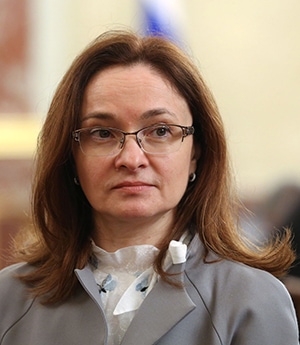Elvira Nabiullina, head of the Central Bank of Russia, articulates the role of monetary policy in the economy.

Global Finance: With pressure on the central bank to do more to stimulate economic growth, how likely are rate cuts at the bank’s next policy meeting?
Elvira Nabiullina: I don’t believe that monetary policy measures can stimulate faster economic growth in Russia. The limits for growth are now of a structural nature, not a cyclical one. The central bank’s role here is to maintain a predictable environment for enterprises and households, which means that we must focus on our inflation target—around 4%—as well as financial stability issues. The latter is very important, considering the situation in the global economy, trade wars and sanctions that Western countries have applied against Russia.
Our monetary policy has fulfilled its mission of reaching the inflation target. And now, after five years of incrementally moving from tight to moderately tight and then to neutral monetary policy, the key rate—which was 7% after the September Board of Directors’ policy meeting—now stands at the upper end of what is judged to be the interval of estimates for the neutral rate.
The Bank of Russia maintains its guidance for the neutral rate range of 6% to 7% in nominal terms, or from 2% to 3% in real terms with expected inflation at our 4% target. The board guided that it would consider whether a further reduction of the key rate at one of the upcoming meetings was appropriate.
GF: How challenging is it to manage political demands for faster economic growth, when the central bank’s chief mandate is to keep inflation in check?
Nabiullina: It is challenging indeed, and this is an issue that most central banks all over the world have to address. The pressure from politicians, mostly populist ones, is increasing as economic growth seems to be more and more fragile. And the key question here is whether a central bank can keep its independence in this climate. I’m convinced that our good track record in terms of reducing inflation from double digits to the 4% target was possible thanks to, among other things, an independent monetary policy.
We are spending a lot of time talking to the general public, experts and officials about the role of monetary policy. The fundamental basis of the central bank’s independence is the public demand for low inflation. When a central bank has a clear mandate and accountable objectives, it helps to contain political pressure. What we keep saying is that although responsible monetary policy establishes a solid foundation for economic development, it cannot be the principal source of a sustainable rise in economic potential. A higher economic growth rate should stem from the implementation of measures aimed at removing structural constraints. This will promote an increase in investment demand and a quicker rise in labor productivity, household income and, accordingly, consumption.
Moreover, there is yet another dimension to the Bank of Russia’s role in economic development. Conditions for growth are more favorable when there is a mature and smoothly functioning financial market. We will also expand the range of financial services and enhance their availability, in particular through digital channels. This will contribute to the quality of economic growth while at the same time adding to the efficacy of monetary policy.
GF: Government spending on national projects are worth an estimated $400 billion. What impact is that likely to have on stimulating economic growth?
Nabiullina: National projects, provided that they are effective, could boost the economy as long as they are aimed at fighting structural constraints that now limit potential growth to 1.5% to 2.0%. If these measures are effective, we expect a positive effect on economic growth starting from 2020. GDP growth is forecast to be 1.5% to 2.0% in 2020, with an acceleration to 1.5% to 2.5% and 2.0% to 3.0% in 2021 and 2022, respectively.
It is critically important that national projects not only increase budget spending on infrastructure and social development, but also support private investments. It is businesses, not governments, that create economic growth.



